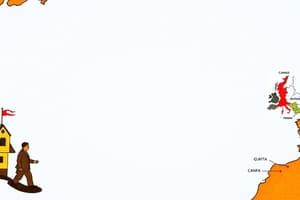Podcast
Questions and Answers
Which of the following colonies was not part of the Southern Colonies?
Which of the following colonies was not part of the Southern Colonies?
- Pennsylvania (correct)
- Georgia
- Virginia
- Maryland
The Quakers started the colony of New Jersey.
The Quakers started the colony of New Jersey.
False (B)
What economic activity was most significant in the New England Colonies?
What economic activity was most significant in the New England Colonies?
Lumbering and trade
The Southern Colonies relied on ___ for labor in planting cash crops.
The Southern Colonies relied on ___ for labor in planting cash crops.
Match the following colonies with their primary characteristic:
Match the following colonies with their primary characteristic:
What was one reason for the establishment of English colonies in North America?
What was one reason for the establishment of English colonies in North America?
The New England Colonies were known for their rich farming soil.
The New England Colonies were known for their rich farming soil.
Which colony was established as a refuge for debtors?
Which colony was established as a refuge for debtors?
The four Middle Colonies were New York, Pennsylvania, New Jersey, and ______.
The four Middle Colonies were New York, Pennsylvania, New Jersey, and ______.
Match the following regions with their characteristics:
Match the following regions with their characteristics:
Flashcards are hidden until you start studying
Study Notes
England's Motives for Colonization
- English settlers arrived in North America for various reasons: economic opportunities, religious freedom, and refuge for debtors.
- England's economic policies, particularly mercantilism, drove the pursuit of colonial expansion.
- England aimed to gain wealth through controlling trade and establishing colonies, using colonies as suppliers of raw materials.
- England turned these raw materials into goods sold to other nations and its colonies.
Colonial Regions and Their Characteristics
- By 1733, thirteen British colonies were established along the Atlantic coastline, grouped into three distinct regions: New England, Middle, and Southern Colonies.
- Each region had distinct climates and resources, influencing lifestyles and attracting specific types of settlers.
New England Colonies
- The region comprised Massachusetts, Rhode Island, Connecticut, and New Hampshire.
- The first settlers sought religious freedom from persecution in England.
- Farming was challenging due to long, cold winters and rocky terrain.
- The economy relied on small farms, lumbering, fishing, shipbuilding, and trade.
Middle Colonies
- Included New York, Pennsylvania, New Jersey, and Delaware.
- Attract settlers from diverse backgrounds, including Quakers, French, Dutch, Germans, Swedes, Danes, Finns, Scots, Irish, and English.
- Landscape varied, from coastal plains to valleys and mountains.
- Farmers grew a variety of crops and livestock.
- Lumbering, shipbuilding, and other industries flourished.
Southern Colonies
- Composed of Maryland, Virginia, North Carolina, South Carolina, and Georgia.
- Characterized by broad rivers, wetlands, and a hot, humid climate.
- Ideal for growing tobacco, rice, and other cash crops, leading to the establishment of large plantations.
- Plantation owners relied on indentured servants and enslaved Africans for labor.
Colonial Government
- All colonies required the king's permission and received a charter outlining boundaries and governance.
- Because of the distance from England, colonies needed to make their own laws and maintain order.
- Most colonies developed their own forms of government.
- The king appointed a governor, able to veto the elected assembly.
- Councils representing English investors played a role in some colonies.
- Massachusetts established a theocracy, but later developed a system of town meetings.
- While more democratic than England, only free, white, landowning men could typically vote.
Settlers and Enslavement
- Freedom of religion and opportunity for a new life drove colonists.
- Colonists, while valuing their own freedom, enslaved American Indians and later Africans.
Regional Development
- New England's religious beliefs and geography shaped its economy and culture.
- Middle colonies represented a melting pot of cultures and religions.
- Southern colonies relied on plantation agriculture and enslaved labor for economic prosperity.
Studying That Suits You
Use AI to generate personalized quizzes and flashcards to suit your learning preferences.





